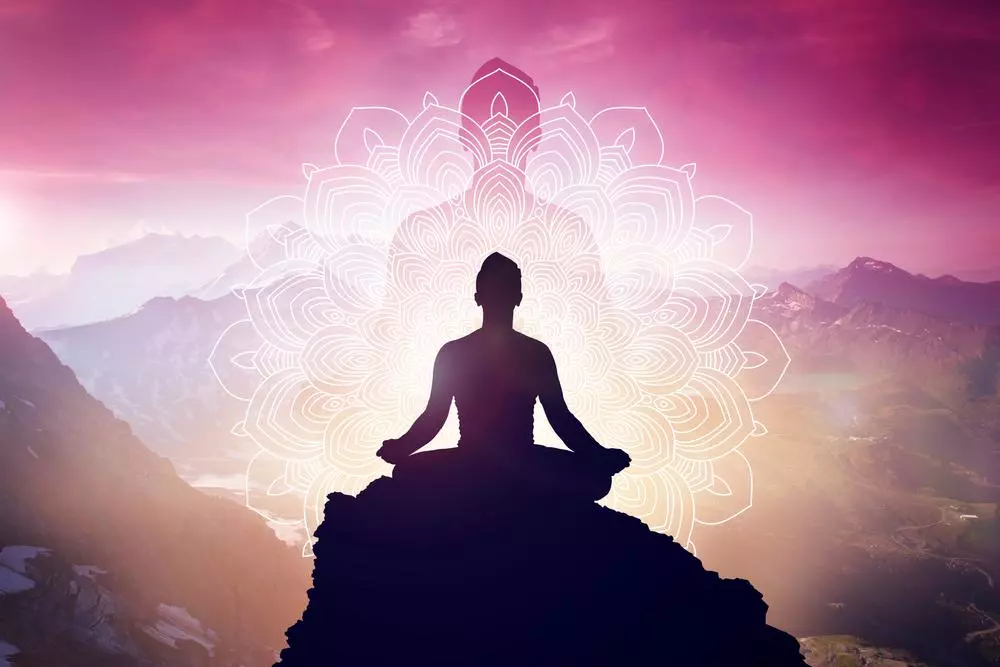
Why should one engage in spiritual practice? What is the purpose of spiritual practice? How can one start on the path of spiritual practice and experience its effects? These are common questions that many beginners in spiritual practice often have. This article aims to address these questions and guide you in understanding the meaning and goals of spiritual practice. If you are just starting your spiritual journey, you can also learn about several safe and effective spiritual practices, the right attitude for spiritual practice, and important considerations.
What is Spiritual Practice? What is its Meaning and Purpose?
Literally, spiritual practice involves correcting one’s behavior, which includes external actions, speech, and internal thoughts and intentions. Since external behavior is primarily influenced by one’s inner state, genuine spiritual practice primarily focuses on transforming the mind. So, how does one transform the mind? Practicing Buddhism is considered one of the most effective methods of inner transformation. Buddha achieved awakening and perfect enlightenment, gaining a deep understanding of the truths of the world. Therefore, following the teachings of Buddha to rectify one’s shortcomings is genuine spiritual practice.
Grandmaster JinBodhi summarized the meaning of spiritual practice in this way: Firstly, it is a way of living, aiming to improve one’s life. Someone who possesses a compassionate and grateful heart will have harmonious family relationships and peaceful interactions with others. They can remain calm and composed in favorable circumstances and deal with adversity with equanimity. Therefore, life becomes one of happiness and ease.
Secondly, spiritual practice is a path to liberation, aiming to transcend suffering. Life is impermanent, and the uncertainty it presents often leads to worry, fear, anxiety, and suffering. However, spiritual practice helps individuals understand the world and the natural order, allowing them to face impermanence with greater equanimity. For example, the law of karma teaches that one reaps what they sow. If someone plants the seeds of unwholesome actions, they will inevitably experience suffering in the future. Conversely, if they wish for a future filled with happiness and auspiciousness, they must begin sowing seeds of virtuous actions now. Additionally, spiritual practice helps individuals gain insights into their own minds, thereby reducing mental afflictions and suffering.
Grandmaster JinBodhi said, “The Buddha sits in your mind, and demons arise from your mind.” Many mental afflictions and suffering are created within one’s own mind. By expanding one’s heart through spiritual practice, learning to understand, tolerate, and be generous, and elevating one’s spiritual state, distortions in perceptions of people and things naturally decrease, and mental afflictions and suffering can diminish significantly or even vanish.
How to Practice Meditation? Understanding Three Suitable Methods for Beginners
In a broad sense, spiritual practice has no specific forms or methods; any activities that help to eliminate unwholesome qualities, move away from greed, anger, and ignorance, and elevate inner qualities and spiritual awareness can be considered spiritual practice.
In a narrow sense, specific and professional methods are used for spiritual practice to cultivate concentration and mental stability. These methods yield more targeted and significant results, but they require guidance from a qualified teacher or training from specialized institutions to ensure safety and effectiveness.
For beginners who may find spiritual practice methods confusing, here are three safe and highly effective methods to consider:
Method 1: The Meditation of Purity
“The Meditation of Purity,” taught by Grandmaster JinBodhi, is a form of visualization meditation. It helps eliminate distractions and focus the mind by visualizing a single thought that represents pure enlightenment. By listening to soothing music and following the guided meditation, you can effectively release the tension accumulated throughout the day, reduce fatigue, and purify your body and mind. Here are the steps for practicing “The Meditation of Purity”:
- Choose a safe and quiet environment with soft lighting and minimal noise disturbance. Prepare a cushion or comfortable seat.
- Wear loose-fitting clothing, preferably made of cotton or linen, for added comfort during meditation.
- Sit cross-legged on a cushion, relax your entire body, keep a calm and composed mind, and focus on the guided meditation and music until the session ends.
- Practice this meditation for at least 30 minutes every day. With time, you will naturally experience the benefits of spiritual practice.
You can obtain the guided music for “The Meditation of Purity” through the Bodhi Meditation College.
Method 2: Prostration for Better Living
For optimal spiritual practice, combining stillness and movement can yield better results. Sitting meditation is a static practice, while the “Prostration for Better Living” involves dynamic movements. It combines stretching of the limbs, spinal exercises, and body movements, which help energize the body, stimulate the meridians, and enhance overall health. This practice is particularly suitable for office workers who sit for extended periods, as it aids in weight loss, metabolism, detoxification, and beauty enhancement. Additionally, it offers benefits for women’s health and cardiovascular well-being. Here are the steps for practicing “Prostration for Better Living”:
- When practicing prostration, it’s important to have a specific object of reverence, which can be a deity, Buddha, or a picture of your spiritual teacher. If you don’t have a specific belief system, you can use a picture of Grandmaster JinBodhi for prostration.
- During prostration, maintain a sense of sincerity and respect. You can offer your body, speech, and mind as an offering to your object of reverence or visualize yourself bathed in auspicious light.
- Perform prostration for at least 30 minutes daily. With consistent practice, you will experience significant benefits and potentially reach higher levels of spiritual attainment.
You can access materials related to “Prostration for Better Living” for free through the Bodhi Meditation College.
Method 3: Energy Bagua
“Energy Bagua” contains the essence of Grandmaster JinBodhi’s years of spiritual practice. It involves simple walking around a tree to quickly replenish life energy, balance the inner state, and is considered one of the dynamic methods of spiritual practice. It is highly effective for improving physical and mental health, enhancing concentration, and focus. It can be beneficial for issues such as insomnia, mental fatigue, cold extremities, and bone and joint problems. For example, practicing “Energy Bagua” can lead to better sleep, improved mood, and enhanced overall health. “Energy Bagua” offers several advantages:
- The movements are simple and easy to learn, suitable for people of all ages, races, and religious beliefs. Anyone capable of walking can practice it.
- Consistently practicing “Energy Bagua” for at least one hour a day over 108 days can significantly improve overall health.
For more information, visit the official Energy Bagua website.
What is Spiritual Practice Sensation? What Attitude Should You Maintain?

Spiritual practice sensation arises from a heartfelt connection. It is about genuinely touching the hearts of buddhas, bodhisattvas, and divine beings with sincerity and reverence. This can lead to various types of sensations. The manifestations of spiritual practice sensation can take different forms, such as:
- Experiencing extraordinary and wonderful states of mind or witnessing auspicious signs.
- Having inspirational or prophetic dreams that provide insights into future events.
- Developing special perceptions or predictive abilities.
For practitioners, spiritual practice sensations often serve as motivation. They allow individuals to witness the wondrous and miraculous aspects of their spiritual journey and personally feel the blessings of buddhas and bodhisattvas, strengthening their faith. However, it’s important to note that spiritual practice sensations are not guaranteed and should not be the sole focus of one’s practice.
They are spontaneous and should not be pursued or rejected. The correct attitude towards spiritual practice sensation is one of equanimity. The main focus should always be on accumulating merits and virtue, and regardless of whether there are sensations or not, maintaining a steady commitment to practice and continuous improvement of one’s spiritual state.
What Are the Benefits of Spiritual Practice? What Changes and Signs Can You Expect When Successful in Spiritual Practice?
What benefits can you gain from spiritual practice? Are there any specific signs or changes that indicate success in spiritual practice? Here are four common signs that indicate successful spiritual practice, as shared by Grandmaster JinBodhi:
- Reduction in Negative Emotions: Spiritual practice primarily focuses on inner transformation. As you diligently practice, your mental state improves, and you become more compassionate, tolerant, and wise. Consequently, you experience fewer hindrances and disturbances to your emotional well-being.
- Attainment of Auspicious Signs: Successful spiritual practice can change your destiny, which can be reflected in your physical appearance through signs of auspiciousness. These signs may include raised mountains on your palms, bright and clear eyes, a serene and composed countenance, a rosy and radiant complexion, enlarged ears with thick earlobes, a higher nose bridge, or the appearance of auspicious moles on your skin. These external signs indicate an increase in merits and blessings.
- Increased Good Fortune and Favorable Outcomes: As your inner compassion and wisdom grow through spiritual practice, your life becomes more auspicious. Good fortune increases, and things begin to go smoothly. Even in challenging situations, you can transform adversity into good fortune and navigate through them with ease.
- Harmonious Relationships: With consistent spiritual practice, your energy and merit increase. This results in improved relationships with others. You attract positive people and opportunities into your life, and you encounter more helpful and supportive individuals.
Bodhi Meditation: Your Professional Spiritual Practice Organization, Guided by Respected Teachers, Eases the Confusion of “How to Begin Spiritual Practice”
Grandmaster JinBodhi is a contemporary spiritual practitioner who has achieved remarkable success in spiritual practice. He founded Bodhi Meditation to help alleviate suffering and bring happiness to all sentient beings. To benefit a wide audience, Grandmaster JinBodhi offers various foundational spiritual practice courses for beginners. These courses introduce simple yet highly effective spiritual practice methods that guide individuals in gradually deepening their practice and attaining physical, mental, and spiritual well-being.
If you wish to experience spiritual practice, you can enroll in meditation courses and follow Grandmaster JinBodhi’s guidance. You can also visit your nearest Bodhi Meditation Center for consultations and experiences. Bodhi Meditation Centers worldwide have professional teachers who provide meditation guidance and share their spiritual practice experiences. For more information, please follow Grandmaster JinBodhi’s Facebook page and subscribe to the Bodhi Meditation YouTube channel.
Further Reading: